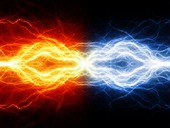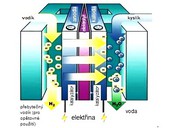Protection against lightning is something other than a lightning conductor. Lightning conductor is for capturing a flash, for safely the grounding system. It is for the prevent injury of people and protection against fire house. If it is all what we will do, we can say goodbye to all the electronics.
Archiv článků od 19.10.2009 do 3.1.2011
The directive 2010/31/EU on the Energy Performance of Buildings – called EPB, EPBD II or EPBD Recast – was passed last May. EU member countries are obliged to implement these new requirements into their national legislations. The implementation of 2010/31/EU was addressed by a number of seminars during the recent Aqua-therm 2010 trade fair. The following article presents you with the most important facts from the presentations and with links to information that was published before and during Aqua-Therm 2010.
The report contains elaboration about make of electrical equipments in the bathroom, in the kitchen and residential as well as non-residential spaces. There are described general charakteristics segmentation of spaces into 3 zones (0,1 and 2). It is including option of equipments into these zones. This report also treat of electrical equipments position in the wash spaces and spaces with massage baths. The report is leaning on present standards with experience context and scientific remarks from different seminars and conferences.
One of ways how to utilise higher amount of energy from solar irradiation is conversion of energy of incident photons to a level close to band gap of the semiconductor material. This is the main idea of thermophotovoltaics. Light from the Sun (or heat from another source) is absorbed in emitter which is heated to a temperature much lower then the temperature of the surface of the Sun. Heated emitter then emits photons with lower energy. The goal is to manufacture selective emitter which emits photons in narrow band only slightly above to bandap of used photovoltaic cell.
The report is focused on analysis earthing of mains and earthing like unit including building services engineering. Safety function of earthing, requirements, practic application and realisation supported by ČSN (Czech Technical Standard). It shows earth electrode project and bonding protection of services engineering in buildings. Function, principles including bonding realisation is supported by Czech Technical Standard and pictures. Report is supplemented description of additional protection – complementing bonding protection internal water supply systems.
This contribution summarizes utilizing of co-generation and tri-generation systems for effective electricity, heat and cool production. A co-generation and a tri-generation offer more effective utilizing of primary energy sources in comparison with separate production of different kinds of energy. This contribution describes actual state in the Czech Republic in year 2009.
Today, many air handling units are supplied with integrated control system. Integration of those controls into a building management system may bring along lots of questions in the design and specification phase. If the parties involved are able to exchange relevant information in time, they avoid delays and problems in supplies and commissioning. AHUs and other components with integrated controls are changing the role of the control system suppliers who have to become system integrators. However, the mechanical part suppliers will have to increase their know-how on communicative controls.
Nowadays, the support for the production is renewable energy is growing. Biomass is among the important sources of renewable energy. It can be used in biogas plants as a raw, organic material of various origins, or as a “dry” biomass with low moisture, which is suitable for the production of energy through incineration. Both electricity and heating can be produced with biomass. And that is actually the problem. Whereas the production of electricity is supported, support for the production of heat is still missing.
The aim of the diurnal lightning proposal is to rectify rooms' access to sunlight, which is dispersed in the atmosphere, and to rectify the visual comfort of the users of the interior during daylight hours; i.e. the appropriate lightning conditions for visual work carried out in the interior. The specifications of diurnal lightning are formulated in IEC-730580-1 to 4. These specifications are binding because the relevant articles mentioned in the standards are determined as binding laws and decrees 268/2009 on the technical requirements for construction, 258/2000 on Public Health, 410/2005 on hygiene requirements for educational facilities and the education of children, Government Decree 361/2007 on sanitary conditions at work. In situations where controls of calculations of measurements are not possible or too difficult, it is then necessary to maximise the transparency of computational procedures. In particular, it is necessary to include all the variables that enter into the calculation (factors of brightness shading barriers, factors of transmission and reflection of light). When assessing the accuracy of the calculations, it is also necessary to require detailed descriptions of the computational models used in determining the individual components of the diurnal lightning factors.
As of the 1st Octo 2009 is in force in the Slovak Republic the decree 311/2009 Z.z., which lays down the details for he calculation of the energy performance of buildings and the contents of the energy certificate. It is a binding document resulting from the law 555/2005Z.z., in which the Directive 2002/91/EC on the energy performance of buildings is implemented.
Alternative energy sources are gradually taking a growing share in the worldwide production of electricity. Solar power is perhaps the easiest to implement and least expensive, its use is not too complicated and can you can easily experiment with it even in a small scale. It is easily accessible to anyone interested in environmentally friendly production of energy. To get started with it, it is just enough to buy one solar panel with a few additional components, and place it on a sufficiently sun-lit place and the production of energy can begin. Certainly, an interesting idea for users is that after the initial investment the system for several years basically doesn't have any requirements, and that it will produce energy for free.
A solar panel (photovoltaic panel or module) is a part of several interconnected solar units with a usual output of around 300W, which generated an voltage corresponding to the multiple voltages of the interconnected individual units. The source of higher outputs consisting of several interconnected solar panels is usually referred to as a solar power plant.
In the 1970's the interest in renewable energy sources increased considerably due to the energy crisis. At that time, the fist extensive and reputable studies were published, which talked seriously about the fact that conventional energy sources are exhaustible. The Czech republic adopted its first energy policy in 1992 in agreement with the regional environmental limits of coal.
Energy Regulatory Office (ERÚ) announced „adequate“ feed-in-tarif (FiT) for photovoltaic electricity. Based on actual situation on Czech PV market it is recommended to reduce FiT for systems below 30 kWp to 11 200 CZK/Wp and for systems above 30 kWp to 9 000 CZK/Wp (actual exchange rate is 25,785 CZK/EUR, see this site).
The recommended values of FiT correspond with actual situation on Czech PV market. Unfortunately exchange rate of Czech koruna (CZK) to Euro is instable. Exchange rate of Czech koruna to Euro oscillate in wide range from about 28 in beginning of 2008 to about 23 in August 2008 and back to about 29 in February 2009. In case the exchange rate will be on upper level the growth of photovoltaic installations will cease. On lower level FiT will be very profitable again.
On other hand future prices of PV modules are unpredictable. Actual rapid fall of prices is mostly based on decrease of price of Silicon as raw material. If the price of Silicon will rise after financial crisis will end, the prices of PV modules will rise too. The prices of modules will probably never exceed last year level, however prices high above 2 €/Wp are possible. According to those uncertainties the FiT could become either excessively profitable or purely restrictive.
zpět na aktuální články



